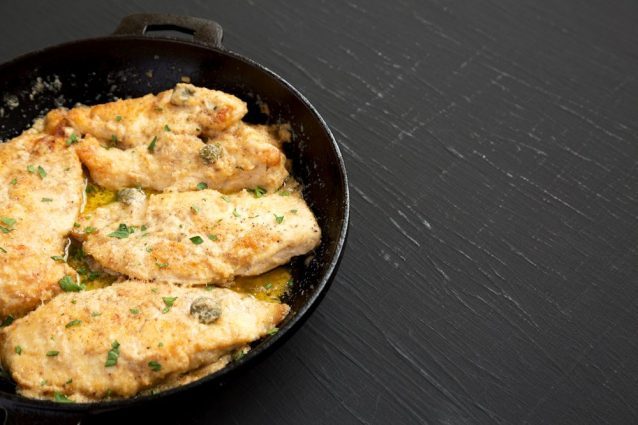Scaloppine: 7 mistakes not to make to have a perfect dish
Scaloppine are a simple dish but always of great effect; they are ready in a few minutes and they can be prepared in many different recipes. However, such simple specialties often hide several problems; if you have tried to cook a scaloppine and the result did not satisfy you 100%, take a look at these 7 mistakes, so as not to make them again.
;)
Scaloppine are a simple dish but always of great effect; they are ready in a few minutes and they can be prepared in many different recipes. However, such simple specialties often hide several problems; if you have tried to cook a scaloppine and the result did not satisfy you 100%, take a look at these 7 mistakes, so as not to make them again.
In the kitchen, the simplest preparations hide the greatest problems; we often think that a dish is particularly easy, but during the preparation we realize that we have done something wrong, without knowing exactly what. An example above all are the scaloppine; a quick recipe but of great effect, which however can become a real disaster if you do not pay attention to some small things.
The scaloppine is a popular preparation that comes from a French specialty; its name, in fact, derives from the French escalope. Whether it is chicken or veal, with mushrooms, lemon or wine, everyone likes scaloppine and it is a very simple specialty to make; as long as you are careful about these possible mistakes, in fact they should never be made.
1. Don't choose the right meat

Chicken, veal or beef are often used indifferently; nothing could be more wrong. Chicken meat, the most common for this dish, is in fact not suitable for all recipes; in fact if the scaloppine is accompanied by tasty mushrooms, it is better to choose beef. Chicken, on the other hand, goes well with lemon scaloppine, thanks to the strong flavoring and its rest in the citrus liquid, which will avoid a dry scaloppine. Same rule for scaloppine in wine; better a more tender meat, such as beef, but not too delicate, to avoid that the flavor of the wine (which must however be simmered) overwhelms the flavor of the meat. Finally, pork is suitable for longer cooking, with wine or broth, and intense flavors, such as that of red wine.
2. Wrong cut of meat

Just like the type of meat, the cut of the meat is also important for a perfect scaloppine. Scaloppine, in fact, needs a cut of meat that is lean but also tender, 2-3 cm high at the most, or you will have a dry and hard scaloppine. But what are the most suitable cuts? As for the veal, it is good to choose rump and fillet, if instead you have chosen pork the best cuts are loin and fillet; if your scaloppine is chicken, however, the classic breast is fine while, if you are more inclined to use turkey, both the breast and the rump are fine.
3. Use only flour

The flour is a protection for the meat, it allows you to make your scaloppine tender and it helps to thicken the cooking base, so as to have a silky cream with which to accompany the dish. But there is not only flour; there are valid alternatives, even gluten free, such as corn starch or rice flour. Try to make a mix too, or to use only one of these two alternatives; in this way your celiac guests can taste the scaloppine in complete safety.
4. Do not use a quality fat

The first rule is to choose the most suitable fat; butter or extra virgin olive oil, as long as they are of quality. Butter goes best with mushrooms, basically, while oil is more suitable if you prepare a lemon scaloppine; but this rule is not mandatory, it depends on your tastes.
5. Cook the meat when the fat is still cold

The scaloppine is not a fried preparation, but this does not mean that it has to navigate in cold oil or cold butter. Putting the meat in a pan when the fat is hot at the right point is in fact essential in order not to have a "boiled" meat, hard or not very tasty.
6. Put all the ingredients together

In the case of scaloppine with mushrooms, but also if you want to accompany the meat with diced vegetables, the fundamental thing is not to put everything together. The food chosen for the combination must be cooked separately and then placed in a pan for a few minutes, before turning off the heat. The same thing goes for juices; if you are preparing lemon scaloppine or orange scaloppine, never cook the liquid together with the meat; otherwise it will give a bitter taste to the whole preparation, as well as harden the meat.
7. Use a random wine

If you have decided to simmer the scaloppine with wine, which is usually done with scaloppine with mushrooms but not only, do not choose a low quality wine or the success of the dish is at stake. White wine or red wine depends on your taste, but also on the meat; a full-bodied red wine will go well with pork while, for veal, beef or chicken, it is better to choose a fresh white wine, perhaps with mineral scents. Finally, you can also try marsala, always with the pork.
;Resize,width=767;)


;Resize,width=712;)
